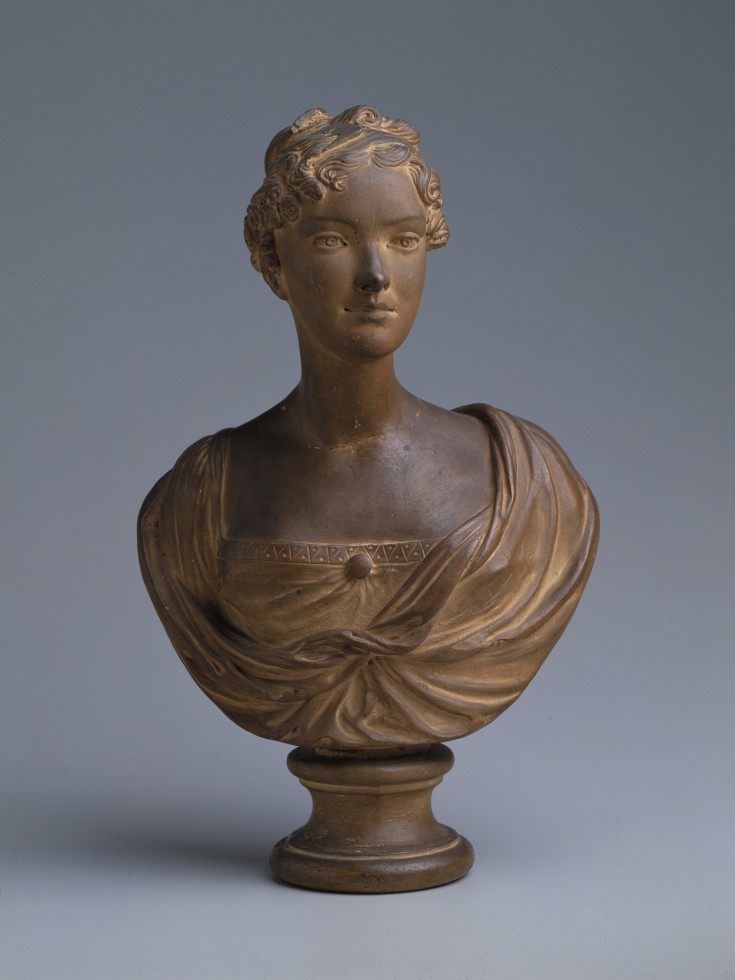Cornelia Jefferson Randolph
Born at Monticello, Cornelia Jefferson Randolph (1799-1871) was the fifth child and third surviving daughter of Martha Jefferson Randolph and Thomas Mann Randolph. Cornelia spent much of her time at the home of her grandfather Thomas Jefferson and, as a young girl, often accompanied him on visits to Poplar Forest. She learned mechanical drawing from Jefferson and practiced by creating renderings of architectural plans for the University of Virginia. When she was a teenager Cornelia gave John Hemmings a dictionary to aid him in learning to read and write.[1]
Jefferson wrote to Cornelia before she could even pen a reply and sent her poems for her scrapbook, such as the "grasshopper's Ball," that he cut from newspapers and magazines.[2] She accompanied her grandfather on his trips to Poplar Forest. In 1817 Jefferson wrote Martha from his retreat and described Cornelia and her sister Ellen as "the severest students I have ever met with. they never leave their room but to come to meals. about twilight of the evening, we sally out with the owls & bats, and take our evening exercise on the terras."[3]
Cornelia never married and lived at Tufton and then Edgehill, the homes of her older brother Thomas Jefferson Randolph. In the 1830s, in an effort to improve the family finances, a school was established at Edgehill where Cornelia taught drawing, painting, and sculpture. She later translated and edited The Parlor Gardener: A Treatise on the House Culture of Ornamental Plants.[4] After the Civil War, Cornelia moved to Alexandria, Virginia, to live with two of her sisters at the home of her niece Martha Jefferson Trist Burke. She died there on February 24, 1871, and was buried in the Monticello Graveyard.
Podcast: Monticello Guide Laura-Michal Balderson discusses Cornelia Jefferson Randolph's relationship with her grandfather, Thomas Jefferson, and highlights her mechanical drawings of the University of Virginia and Monticello's first floor.
(Approx. 3 min.)
Further Sources
- Library of Congress. Thomas Jefferson Papers. (Search for "Cornelia".)
- Randolph, Cornelia. Commonplace Book. n.d. Library of Congress. Randolph Family Manuscripts. 1790-1889. Thomas Jefferson Papers Series 6.
- Randolph, Cornelia. Drawing N-563, "Monticello. Two sketches of plan showing location of furnishings and works of art," post July 4, 1826. Jefferson, Randolph and Trist Family Papers [manuscript] 1791-1874, #5385-ac. Special Collections. University of Virginia Library.
- Malone. Jefferson. See 6:286.
- Shackelford. Descendants. See 1:147-53, 1:253.
- Thomas Jefferson Foundation. Jefferson Quotes and Family Letters.
References
- ^ Cornelia J. Randolph to Virginia J. Randolph (Trist), October 25, 1816, Nicholas Philip Trist Papers, University of North Carolina. Transcription available at Jefferson Quotes and Family Letters
- ^ Jefferson to Ellen Randolph, March 1, 1807, in Family Letters, 296. Transcription available at Founders Online.
- ^ Jefferson to Martha Jefferson Randolph, August 31, 1817, in PTJ:RS, 11:669-70. Transcription available at Founders Online.
- ^ Cornelia J. Randolph, trans., The Parlor Gardener: A Treatise on the House Culture of Ornamental Plants. Translated from the French and Adapted to American Use (Boston: J.E. Tilton & Co., 1861).
